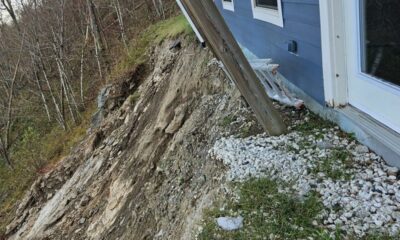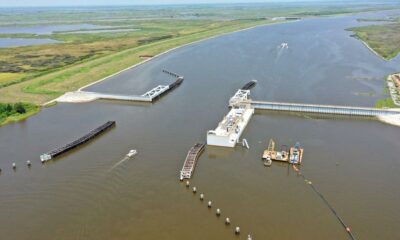News from the South - North Carolina News Feed
When will railroad tracks get repaired here? Why so many water alerts? What type of clay is causing the turbidity problem? Could the city directly pipe the clear streams nearby? • Asheville Watchdog
Today’s round of questions, my smart-aleck replies and the real answers:
Question: Will Norfolk & Southern repair their tracks? It’s such a sleepy industry, they may not be able to get a return on the investment. Rails to trails?
My answer: When it comes to repairs, I feel like Norfolk Southern is saying more, “I think I can, I think I can,” rather than, “Yeah, these tracks are toast. Time for rails to trails.”
Real answer: Norfolk Southern owns a lot of our tracks around here. Company spokesperson Heather L. Garcia provided the company’s update on Helene recovery.
“The short version is our track in and out of Asheville is expected to be out for at least another three months,” Garcia said.
The track is still used quite a bit, although Norfolk Southern does consider it “secondary” track, not part of its mainline operations.
“Essentially, that means most of the traffic on that track is local (as opposed to through traffic), serving customers that are shipping goods out or bringing products in,” Garcia said. “Coal, forest and consumer categories make up more than half of the traffic in that area normally.”
In that update, Norfolk Southern said all of its “core routes were open within 72 hours of the hurricane making landfall.” The railroad has 19,500 miles of track in 22 states, mostly in the East.

“Norfolk Southern’s Engineering team cleared over 15,000 trees, repaired multiple washouts and over 50 damaged slide fences, deployed 400-plus generators, and safely operated in more than 1,000 locations without commercial power,” the update stated.
The update notes that the Asheville region was hard hit.
“In the hardest hit areas, along Norfolk Southern’s AS Line, which runs from Salisbury, N.C to Morristown, Tenn., crossing the Eastern Continental Divide through the Blue Ridge Mountains and Asheville, N.C., initial damage assessments discovered 21,500 feet of track washed out, more than 50,000 feet of track damaged by scour, over 15,000 feet of fill failures and slides, and multiple bridges damaged,” Norfolk Southern stated. “Engineering teams reopened the AS Line between Salisbury, N.C. and Old Fort, N.C., as well as between Newport, Tennessee and Morristown, Tennessee, Oct. 9, working, in some cases, without access to public roadways.”
Because of the remoteness and mountain topography, along with storm flooding, “Norfolk Southern teams have had difficulty assessing damage along portions of the line around Asheville and over Black Mountain, where much track has been completely destroyed,” the company stated.

“Initial projections estimate Norfolk Southern’s line between Asheville and Newport will reopen by late January 2025,” the update continued. “Evaluations of the track between Asheville and Old Fort are ongoing.”
Blue Ridge Southern Railway, under its parent company, Watco, also operates tracks in our area, running from East Flat Rock up to Asheville, and then west to Dillsboro. The “WAMX” locomotives you often see around here, which stand for Webb Asset Management, are part of the Blue Ridge Southern Railroad.
The Blue Ridge Southern line consists of 87.83 miles of track, according to Watco spokesperson Tracie VanBecelaere.
“The Blue Ridge Southern Railroad is working to restore the line to resume service to our customers,” VanBecelaere said via email. “We do not have an exact timeline right now on when work will be completed, but hopefully in a similar timeframe as Norfolk Southern.”
As far as any potential transitioning of tracks to pedestrian/cycling trails, that’s not happening.
“There is no discussion of trail projects resulting from the storm,” VanBecelaere said.

Question: I appreciate the city being responsive during this crisis, but do they really need to send out so many alerts about the water? It’s starting to drive me crazy.
My answer: Alert! Alert! Alert! An Alert answer is coming. Hey, I just wanted to warn you.
Real answer: Asheville City Manager Debra Campbell broached this subject at the Oct. 21 daily Helene briefing. In short, the city must issue these notices.
“We’ve heard a lot, and a lot of it were mostly complaints that there’s been some frustration with the daily AVL alert messages going out to Asheville water customers as we continue to bring the entire water system back online,” Campbell said. “These daily boil water notices are required by the Environmental Protection Agency.”
“As long as we are under a boil water notice, we appreciate your understanding of the necessity of these critical messages,” Campbell continued. “These alerts are sent in both English and Spanish to ensure we reach as many members of our community as possible.”
Asheville has restored water to nearly all its customers, but the water is not filtered, and it’s heavily chlorinated and can have a light brown appearance. This stems from stubborn suspended clay particles remaining in the city’s main drinking water source, North Fork Reservoir in Black Mountain.

Question: (Note: Two readers asked about the turbidity issue at North Fork Reservoir. I’m summarizing their questions here). One guy said he filtered the city water through three towels, and it still came through with a brownish color, and yet there seemed to be no residue left behind on the towels. This indicated to him that the particles in question are incredibly fine. Along those lines, another guy, with experience in pottery, asked if the type of clay in the reservoir might be something called “terra sigillata.” Apparently, this is a fine clay used to create a smooth, lustrous coating on ceramic pieces, according to Google. His point is that it is a very, very fine clay and stays in suspension for a long time. He wanted more specifics on the suspended clay the city is dealing with, other than just generic clay. Also, he asked if the curtains to be installed are effective on very fine clay particles. And, how small a particle can they filter?
My answer: I’ve yet to hear the city’s water spokesperson, Clay Chandler, acknowledge the awkwardness of being named “Clay” these days, but I suspect that’s coming. I also suspect he’s already had some people blame him personally for muddying the waters.
Real answer: Chandler said the particles in North Fork that are causing the murkiness, technically called turbidity, are “very fine clay particles and generally require a coagulant to remove.

“A towel is porous, with those pores being large enough that they would most likely be unable to trap or contain those particular particles,” Chandler said via email. “Our personnel have not identified the specific clay particle, and use that term generically to describe many variations.”
They clearly have looked at this clay up close and personal, though.
“We do know that these particles are small, flat, plate-like structures, with a negative charge, and they act as opposing magnets, which keeps them suspended in the reservoir,” Chandler said.
Regarding the turbidity curtains, which the city is installing this week, they “are impervious in areas, but are mostly intended to create a stilling zone to allow flocculation and mass building, which we hope will help these particles sink,” Chandler said.
Flocculation is a fancy way to describe a process that causes small particles in a liquid to clump together into larger clusters called flocs. Hey, that’s what Google AI tells me.
Floc away, Asheville!

Question: As the feeder streams to North Fork have cleared, has the city explored the possibility, maybe in conjunction with the Corps of Engineers, of directly piping the stream water into the treatment facility, essentially bypassing the lake? Is this possible? Too complex?
My answer: At this point, I think the city has explored every possible solution to restoring potable water to its citizens, including buying gigantic tanks of hydrogen and oxygen and leaving them in a room overnight, hoping some magic occurs.
Real answer: This would probably be too complicated to seriously consider.
“Lot of problems to solve,” Chandler said. “None of those feeder streams are very deep, so you’d run into the capacity issue there, too. Also, they’re all in the middle of thick forest, and getting what would likely require a few miles of connected pipe laid and stabilized would take a significant amount of time.”
Also, the terrain provides no good place to set up dozens of pumps and other equipment that would be required to make this work.
Asheville Watchdog is a nonprofit news team producing stories that matter to Asheville and Buncombe County. Got a question? Send it to John Boyle at jboyle@avlwatchdog.org or 828-337-0941. His Answer Man columns appear each Tuesday and Friday. The Watchdog’s reporting is made possible by donations from the community. To show your support for this vital public service go to avlwatchdog.org/support-our-publication/.
Related
The post When will railroad tracks get repaired here? Why so many water alerts? What type of clay is causing the turbidity problem? Could the city directly pipe the clear streams nearby? • Asheville Watchdog appeared first on avlwatchdog.org
News from the South - North Carolina News Feed
Poll: Robinson did not hurt other candidates | North Carolina
SUMMARY: A recent poll indicates that nearly half of respondents believe Lt. Gov. Mark Robinson’s issues did not affect their voting choices. Robinson lost the gubernatorial race to Democratic Attorney General Josh Stein, with his campaign suffering from a CNN report linking him to a past porn chat room. Despite this, 50.1% of voters now feel America is on the right track, an increase from previous months. Stein holds a 53.2% approval rating, and other elections resulted in a split of statewide positions between Democrats and Republicans. The poll included 615 responses with a margin of error of +/- 3.94%.
The post Poll: Robinson did not hurt other candidates | North Carolina appeared first on www.thecentersquare.com
News from the South - North Carolina News Feed
Helene: Assistance of $227M overshadowed by authority changes | North Carolina
SUMMARY: The North Carolina General Assembly has passed legislation providing $227 million in fiscal recovery aid for Hurricane Helene, totaling $1.1 billion in assistance for various disaster relief efforts. The bill also includes significant changes to authority for state leaders, such as placing the State Board of Elections under the State Auditor’s office and restricting the attorney general’s ability to challenge the General Assembly. Critics, predominantly Democrats, argue these modifications serve Republican interests and compromise election integrity. The legislation reflects ongoing political tensions, exacerbated by recent court challenges and contentious executive actions during COVID-19.
The post Helene: Assistance of $227M overshadowed by authority changes | North Carolina appeared first on www.thecentersquare.com
News from the South - North Carolina News Feed
At least 3 of 43 fatalities in Buncombe were unhoused people • Asheville Watchdog
Asheville Watchdog is bringing you the stories behind the staggering loss of life from Helene, the children, parents, grandparents, multiple generations of a single family, all gone in one of the worst natural disasters to hit the mountains of western North Carolina. This is the seventh installment.
Buncombe County’s homeless advocates feared the worst: Helene would be deadly for the dozens of unhoused people living along the banks of rivers and streams that turned into raging floodwaters.
“We thought that the death toll just in this population was going to be up in the 20s, 30s, just because of how many people camp on the rivers,” said Alanna Kinsella, homeless services director at Homeward Bound.
Read previous installments of The Lives We Lost.
Asheville Watchdog has identified three unhoused people of the 43 who perished in Buncombe from the Sept. 27 tropical storm: Jody Henderson, an Air Force veteran described by his sister as extremely loving, Calvin “Michael” McMahan, who liked to travel and preach to people he met, and Lisa Plemmons, a cook at an Asheville nursing home who was living in her car and had been featured in a previous installment of The Lives We Lost.
About five unhoused people remain unaccounted for, Kinsella said.
“Did they leave town before? Do we have their legal name? It’s really hard to know,” she said. “It could only be one or two people that are really actually missing.”
The toll on Asheville’s homeless community turned out to be lower than feared. The Asheville-Buncombe Homeless Coalition called a Code Purple beginning the morning of Sept. 26, opening shelter space for anyone who needed it and providing free bus transportation.
Teams that included community paramedics and outreach workers visited homeless encampments to warn people near water and urge them to seek shelter. Advocates were also able to spread the word about Code Purple early because of the persistent rains ahead of the storm.
At AHOPE, a day shelter run by Homeward Bound, “so many people were coming in here at that time because people needed to get dry, they needed to get supplies,” Kinsella said. “We were really able to disseminate that information really quickly.”
Many went to shelters, “and a lot of our campers really moved into the core of town,” Kinsella said.
In the weeks after the storm, advocates have been attempting to account for everyone. Asheville’s 2024 Point-In-Time count identified 739 people without housing, most in emergency shelters or transitional housing, but 219 were camping, sleeping in cars or on the street.
The task has been difficult because some homeless people were known only by aliases or street names.
“It really took an entire community of us to come together and say, ‘Okay, I know that person’s legal name,’ or ‘I only know them by this,’“ Kinsella said. “It was a lot of really having to piece things together.
“It may be a while before we know the full scope of who all from our community, of people experiencing homelessness, have been lost.”
Here are two of their stories.
Jody Henderson
Jody Henderson’s life never was easy, but he “was one of the most loving people you would ever meet,” said his sister, Kathy Henderson Cook.
Her younger brother struggled with bipolar disorder and was often homeless and unable to work. Henderson had a high IQ and was good looking, she said, but the disease kept him hamstrung for most of his adult life.
“He had so much going for him, but he just couldn’t put that grasp on things and just stay with it,” Cook said. “He would float off, and then he would just get kind of loopy.”
Henderson, 63, died Sept. 27, swept away by Helene’s floodwaters, according to his death certificate.
He had been staying at the Veterans Restoration Quarters on Tunnel Road in East Asheville, but Cook said he’d spent a couple of weeks at the VA hospital for mental health treatment.
On the day before Helene, Henderson was on a “weekend pass” from the VRQ and rented a cabin along the Swannanoa River at the KOA Campground. He needed a space that would accept dogs, as he didn’t want to go somewhere without his beloved mutt and emotional support dog, Bullet.
Cook said that on Sept. 27, as the river breached its banks and the water rose, her brother was standing on top of the cabin. An evacuation team had just arrived. As he often did when his situation was dire, Henderson called his sister.
“He called me at 9:17,” Cook said.
Their conversation was short.
“He said, ‘Sis, I love you. The evac team just arrived. I’ll call you,’” Cook said. “He hung up, and he was gone.”
A witness at the campground said “it was around 10 o’clock when the building collapsed and everything went crazy,” Cook said.
Jody Nyle Henderson grew up with Cook in Chesnee, South Carolina, and had lived in California, Utah, Nevada, North Carolina and Texas before returning to Chesnee in 2018, according to his obituary. He attended Chesnee High School and Spartanburg Community College before joining the U.S. Air Force.
He is survived by three children, Cook and another sister, Kristi Henderson Walker. A brother, Michael Kenneth Henderson, died previously.
“His final days were in a log cabin with his beloved dog Bullet by the Swannanoa River with a view of God’s beautiful creation surrounding him as he made new friends,” his obituary states. “Bullet was adopted by one of those new friends, Chelsea of Maryland, who rescued Bullet from the flooding.”
Cook said her brother easily made friends, including Chelsea, whom he met at the campground. She did not want her last name published.
“He’d never met her. Didn’t know her, but of course, you know — two hours with Jody — best friends,” Cook said.
Cook, who called her brother “Bo,” said his death has been difficult, and she still has “moments where I tend to struggle with emotional issues.
“But as a whole, I know this was a blessing from God,” Cook said, explaining that she always worried about her brother, especially when he stopped his medications and was unhoused.
He would end up in need and then call to come stay with her, she said.
“He would do anything for me — he just didn’t have the ability to fight the disease,” Cook said. “And I don’t hold that against him.”
She noted that her brother suffered from “tall tale syndrome,” exaggerating facts or making up stories.
She and her sister take comfort knowing that Henderson went out with a story that would normally be hard to believe, one involving a historic storm that showed immense power and swept away entire buildings.
They’ve also taken comfort in the outpouring of support from the community, from churches to governmental agencies.
“It was a blessing to have to lose somebody and be as fortunate as we are in a community like we live in, to have people come together,” Cook said.
– John Boyle, Asheville Watchdog
Calvin “Michael” McMahan
Calvin McMahan’s sister feared the worst after Helene when she did not hear from the big brother who never went more than a few weeks without checking in.

The last she knew, McMahan, who went by his middle name, Michael, had been in Asheville, said Pamela Douthit of Bryson City. “I was wondering where he was, hoping he was okay, worried to death,” she said.
Douthit said police told the family that McMahan had drowned in the storm. His body was found Sept. 30 on Glendale Avenue along the Swannanoa River in one of the areas hardest hit by flooding.
The official cause of death was “landslide injuries,” according to his death certificate.
McMahan, 63, was the oldest of 10 children and had been unhoused for the past 15 to 20 years, his sister said.

“He lived everywhere,” she said. “He had property here in Swain County, but he wanted to travel. He wanted to visit different places, so he decided being homeless was his choice.”
McMahan liked to preach to the people he met. “He testified to people,” Douthit said. “He talked about God and how free we are and how thankful we are.”
McMahan visited his sister and her husband in Bryson City from time to time and would stay for a couple of weeks. “He said he had to do God’s work, so he went on out down the road,” she said.
McMahan had been staying under a bridge near the Swannanoa. His sister said he frequented homeless shelters in bad weather and must not have known about the dangerous flooding predicted in Helene.

“I guess it just snuck up on him. He was asleep or something,” she said. “I hate that he had to go the way he did.”
McMahan had a son and a daughter in Florida, she said. He had been a house painter and loved the guitar, though he did not know how to play.
“Like anyone else, he made mistakes, but he tried to do the best he could do for other people,” Douthit said.
McMahan had “some trouble with the law…He changed his life, and he started working for the Lord and doing what the Lord said to do. I was proud of that,” his sister said.
“I loved him. He was a good person,” she said. “He will be missed.”
– Sally Kestin, Asheville Watchdog
Asheville Watchdog is a nonprofit news team producing stories that matter to Asheville and Buncombe County. John Boyle has been covering Asheville and surrounding communities since the 20th century. You can reach him at (828) 337-0941, or via email at jboyle@avlwatchdog.org. Sally Kestin is a Pulitzer Prize-winning investigative reporter. Email skestin@avlwatchdog.org. The Watchdog’s local reporting during this crisis is made possible by donations from the community. To show your support for this vital public service go to avlwatchdog.org/support-our-publication/.
Related
The post At least 3 of 43 fatalities in Buncombe were unhoused people • Asheville Watchdog appeared first on avlwatchdog.org
-

 Our Mississippi Home7 days ago
Our Mississippi Home7 days agoCreate Art from Molten Metal: Southern Miss Sculpture to Host Annual Interactive Iron Pour
-

 Local News5 days ago
Local News5 days agoCelebrate the holidays in Ocean Springs with free, festive activities for the family
-

 News from the South - Georgia News Feed6 days ago
News from the South - Georgia News Feed6 days ago'Hunting for females' | First day of trial in Laken Riley murder reveals evidence not seen yet
-

 News from the South - Alabama News Feed6 days ago
News from the South - Alabama News Feed6 days agoFirst woman installed as commanding officer of NAS Pensacola
-

 Kaiser Health News3 days ago
Kaiser Health News3 days agoA Closely Watched Trial Over Idaho’s Near-Total Abortion Ban Continues Tuesday
-

 Mississippi Today5 days ago
Mississippi Today5 days agoOn this day in 1972
-

 News from the South - Alabama News Feed2 days ago
News from the South - Alabama News Feed2 days agoTrial underway for Sheila Agee, the mother accused in deadly Home Depot shooting
-

 News from the South - Alabama News Feed2 days ago
News from the South - Alabama News Feed2 days agoAlabama's weather forecast is getting colder, and a widespread frost and freeze is likely by the …

































